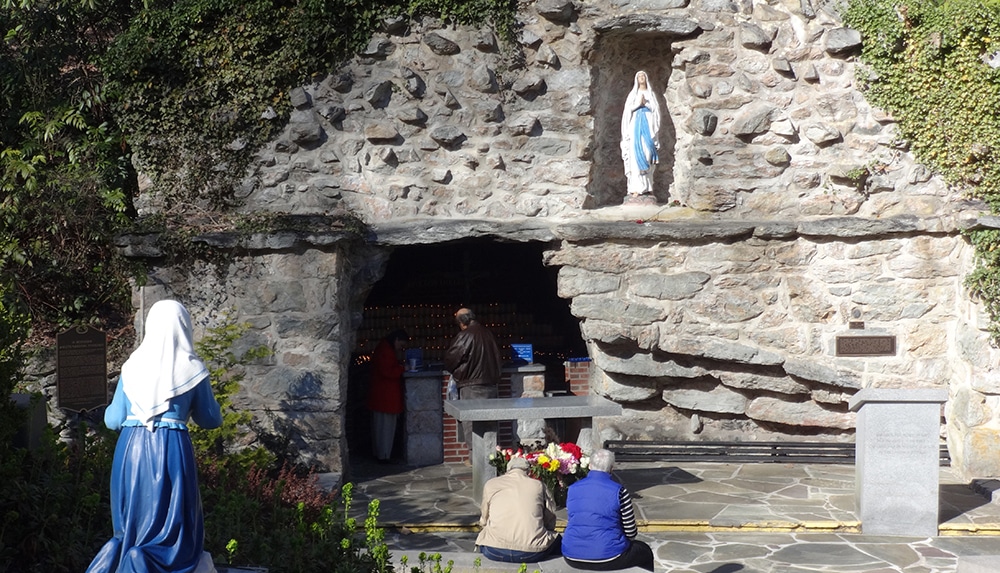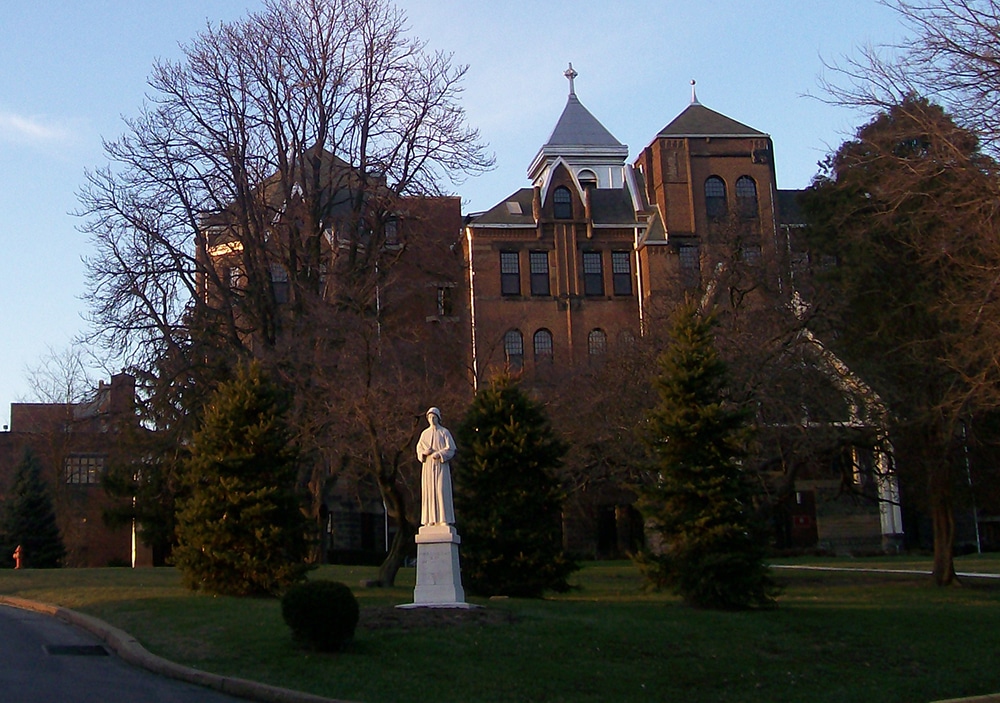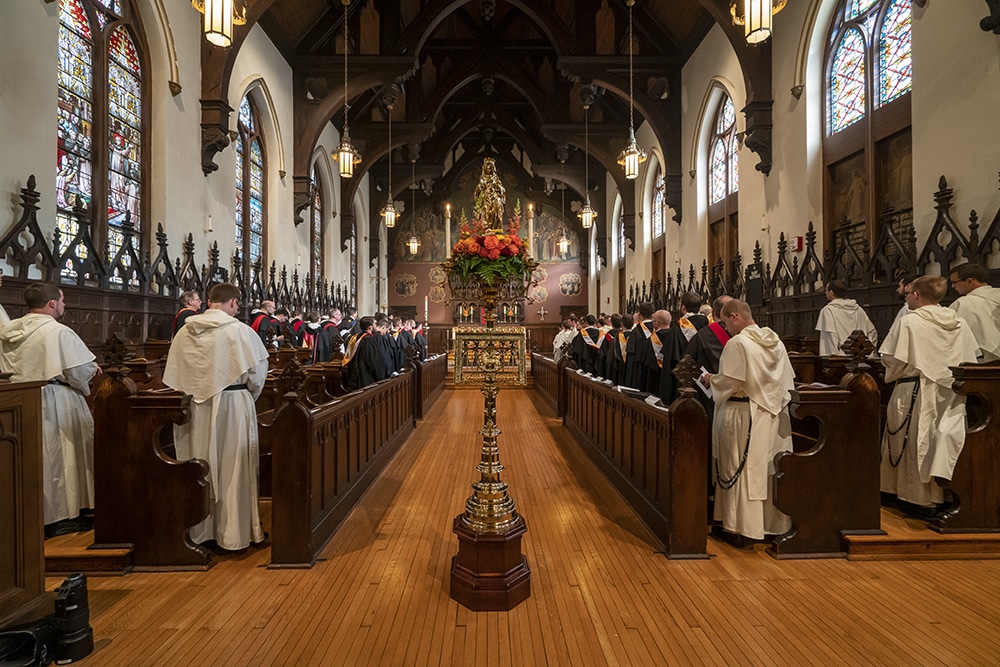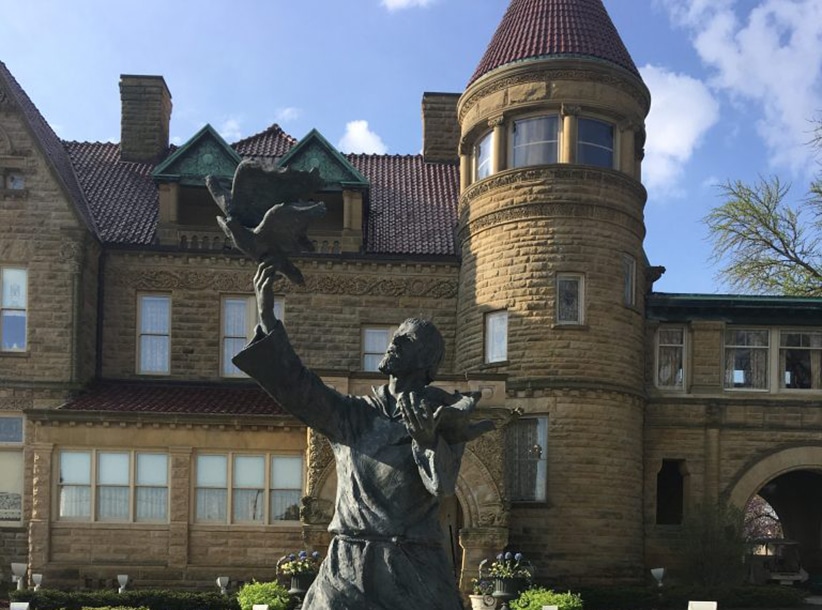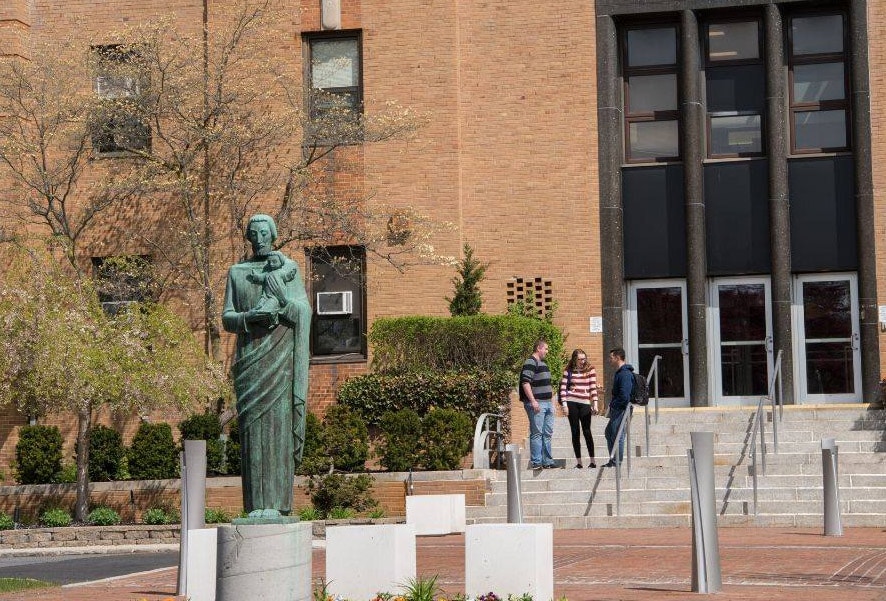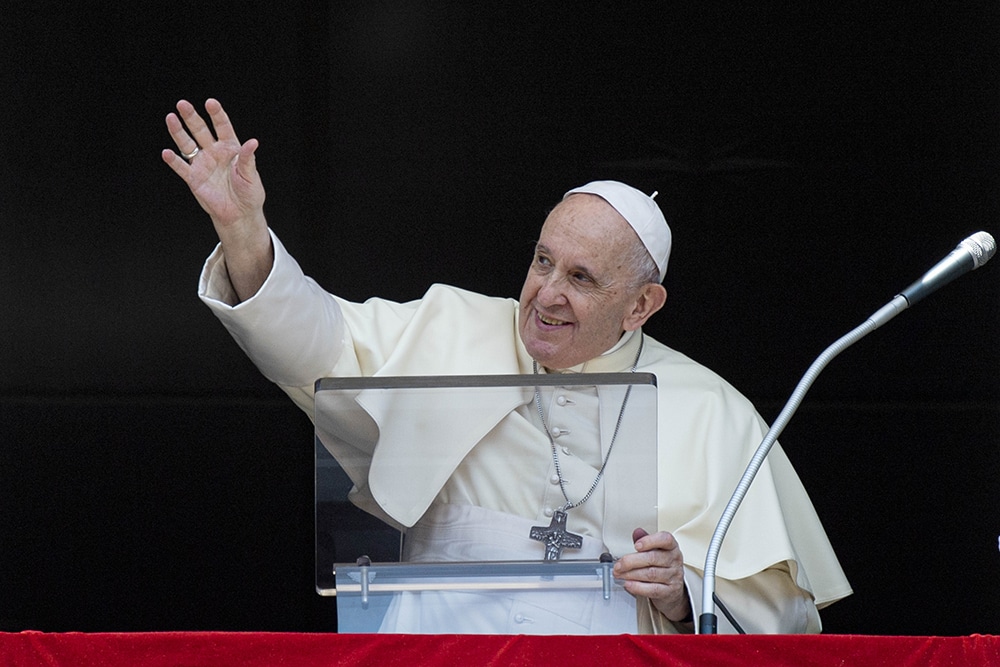When Jay Phillips was looking at colleges with his mother more than 20 years ago, they were approaching Emmitsburg, Maryland, looking for Mount St. Mary’s University.
“We came around a bend, and there was this big, gold statue of Mary,” said Phillips, now the university’s director of cross country and track and field. “I was like, ‘I guess that’s where we’re supposed to be.'”
Phillips went on to earn bachelor’s and master’s degrees in theology from Mount St. Mary’s, the second-oldest Catholic university in the United States and the first named for Mary, and he now coaches the same teams he ran with as a student.
Now, he says, he understands Mary has an active presence at the school, which boasts the 26-foot gold leaf statue made to stand atop the mountain and the National Shrine Grotto of Our Lady of Lourdes.
“From my specific standpoint, I do a lot of recruiting, and I just get the sense that Mary brings people here, people who she wants to be on this mountain,” Phillips said.
Over his years at the school, he has developed his own relationship with Mary, and it’s not flowery or academic.
Read more from our Catholic Colleges Fall 2021 special section here.
“She’s my mother, and I need her,” he said. “Like my physical mother, I take her for granted. I probably don’t call as often as I should, but she loves me and she prays for me and I am who I am because of her.”
Students, faculty and staff members and administrators at schools named for Mary all over the country said that “mother” is one of the main roles the Blessed Virgin fills on their campuses. She is also an example and a role model, a guide and an intercessor, they said.
Looking to Mary’s example
Jessica González Uhlig, associate provost for academic administration and mission at St. Mary’s University in San Antonio, said she grew up in San Juan, Puerto Rico, with a very pretty, very European picture of Mary on the wall.
It wasn’t until she was a college student at Dayton University in Ohio, which like St. Mary’s is a Marianist institution, that she saw Mary as more than an idealized portrait of a saint.
Uhlig said she attended a workshop at the University of Dayton on the different faces of Mary and was introduced to the versions of Mary that are popular in cultures around the world.
“There were images of her in different colors, different races and ethnicities,” Uhlig said. “She was portrayed as a strong woman. She was also portrayed as young, scared, practically a teenager. All these images really resonated with me, I just felt this connection, almost a sisterhood, with her: young, scared, faith-filled, but saying yes to this craziness, all the way up to Mary at the foot of the cross.”
It’s that image at the foot of the cross that resonates with AJ Klutho, a senior at St. Mary’s in San Antonio and a member of the university’s Marianist Leadership Program.
“I can just imagine seeing my child die the most humiliating death, the most painful death in existence at that time, and to watch my child … the relationship between a mother and a son is so intimate, and one of the greatest pains anyone can experience is a mother losing a child,” Klutho said. “But she had to experience it, she had to go through it saying, ‘God, I trust you.’
“Going back to the conception of Jesus, she had a choice to say no, but she said yes, and she kept saying yes until the end of Jesus’ life. Life is far from easy, and life leads us down crazy roads. All God and Jesus are asking us to do is trust him.”
Ana Rojas, also a senior in the Marianist Leadership Program, said she followed that example of trust last year, when she was asked to speak about her relationship with Mary to the nearly 100 students in the program.
“When I have a challenge, sometimes I think, I’m too young and I’m still in college,” Rojas said. “Seeing the things that Mary was able to say yes to at such a young age, I know I’m capable of more than I think. When I was asked to talk in front of the MLP, I felt very nervous and shy about it, but I felt like Mary was calling me to do it. I needed the push.”
Uhlig loves seeing students take inspiration from Mary, she said.
“Strength, motivation, ongoing faith, someone who just had to believe in something greater than herself gave her gift to the world,” Uhlig said, listing attributes students can emulate.
Mother of all
Lasallian Christian Brother Robert Smith, senior vice president for presidential initiatives at St. Mary’s University of Minnesota, said he would like students at his university to look to Mary for many of the same reasons.
“We certainly would talk about Mary and her various and many titles,” Brother Robert said. “Mary is a model of fidelity and saying yes, saying yes to God’s invitation when she was young and scared and didn’t know what was going on. Sometimes I think there might have been a dozen Marys who said no, and this Mary said yes.
“For a faithful Christian, what does it mean to say yes, over and over again, from conception to death? Don’t think Mary wasn’t scared, and don’t think she wasn’t confused and don’t think she wasn’t shaking in her boots.”
Mary is addressed in theology classes, of course, Brother Robert said, and in the general education classes that all students take, but she also is a regular part of the prayers that open and close liturgies and other events on campus.
John Cavadini, a theology professor and director of the McGrath Institute for Church Life at Notre Dame University, said that Mary is ever-present on his school’s campus as well, from the statue on top of the trademark golden dome to the Marian transept windows in the Basilica of the Sacred Heart.
Perhaps the best-known Marian spot on campus is the Grotto of Our Lady of Lourdes, he said.
“There’s almost no time when you won’t find students, faculty, staff and or visitors there lighting candles,” Cavadini said. “Even in the middle of the night, students go there. … There is a lot of interest in Mary here, among the students especially, and among a number of the faculty. You could say there’s a kind of critical mass who are interested in preserving and fostering the Marian character of the school. The grotto is the most revered place on campus. That devotionally holds the whole university together.”
Cavadini hopes to encourage that devotion and a renewed interest in Marian scholarship by creating a new center within the Institute for Church Life.
In the areas of scholarship and devotion, the center already has hosted a conference on the state of Mariology on the cusp of Vatican II and has reinstituted a university May crowning, Cavadini said, and expanded celebrations of Marian feast days.
“She is the mother of God,” Cavadini said. “That means that devotion to Mary is intrinsic to Christian worship. It’s not just icing on the cake. Devotion to Mary is ordered to the worship of the Incarnate Word, who is a person and not a concept. Concepts don’t have mothers. The Incarnate Word has a mother, cried like all other babies and was completely dependent on his mom.”
Now Mary is the mother of all, Mount St. Mary’s Phillips said, something that is important on a diverse campus.
“I see her spiritual motherhood of all of us,” he said. “It’s like she’s saying, ‘I’m not just the mother of the daily-Mass-going Catholics at Mount St. Mary’s. I’m going to show you who I’m mother of, and it’s everyone: the Catholics and the other Christians and people of other religions and even the so-called nones.”
A personal relationship
But there’s no denying Mary has a special pull for Catholics.
“I don’t know that I would have ended up in Emmitsburg if there had not been that connection,” said Mary Catherine Kennedy, associate professor of communications at Mount St. Mary’s. “I had always had a devotion to Mary.”
Kennedy said she took ownership of her faith early, being the only Catholic student in her elementary school class in South Carolina, and her relationship with Mary deepened after her mother died about a decade ago. She started a consecration program to Mary on the date of her mother’s death and made her consecration on Jan. 1, the solemnity of Mary, Mother of God.
“It was important that it was not just a Marian feast day, but it was about her motherhood,” she said.
Now she tries to embody the spirit of Mary with her students, sometimes taking freshmen up the mountain to the Lourdes grotto, which lies under the statue.
“Having that golden statue — it’s an omnipresent type of thing,” Kennedy said. “It can be seen as a ray of hope, a ray of light. I took students up there not just to see the statue but to look at the view from that point of the mountain. You can see the whole campus spread out below you. They would come up out of breath, and I’d say, ‘The climb up here wasn’t easy. You can do anything through effort and saying yes.'”
Emily Jansen, a junior and the student body president at Mount St. Mary’s, said the message comes through loud and clear.
“Mary is frequently mentioned in speeches and in classes — especially in theology classes — even just in conversation,” she said. “A lot of the students, we call her Mom. It’s casual, but it’s also personal and intimate.”
This year will be different, since the statue on the mountain has been temporarily removed for repairs.
Jansen plans to address it in her speech to students opening the school year.
“I’m going to say something like, ‘Mary has the year off. We get to be Mary now.'”
Michelle Martin writes from Illinois.

